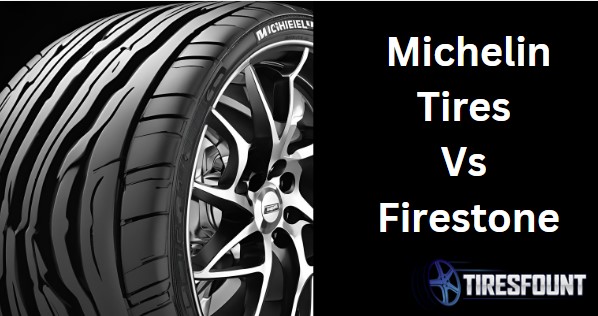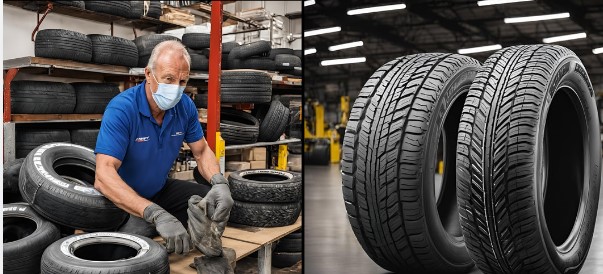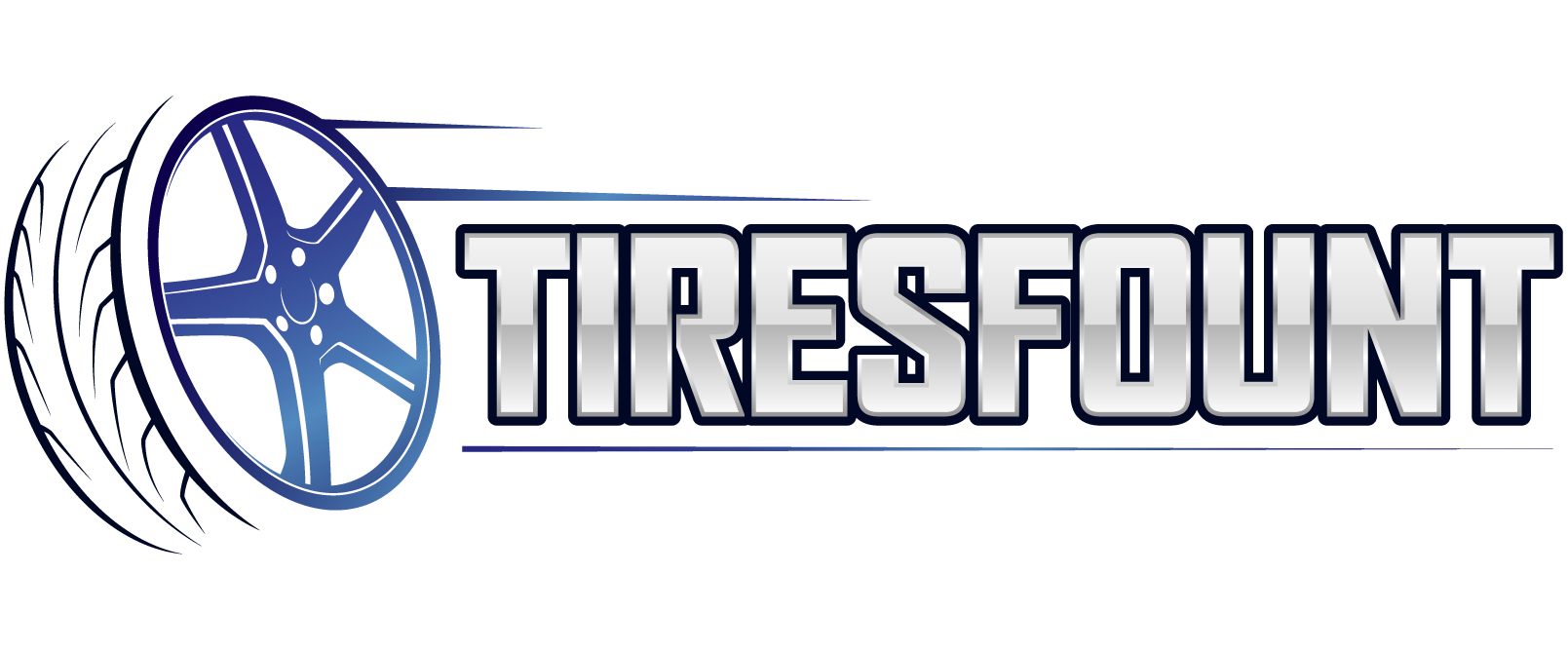It depends on your vehicle and uses. Let’s dig deeper.
Michelin is recognized as the most awarded tire brand in the United States, consistently ranking number one across various categories and segments according to both industry experts and consumers.
Firestone, now a part of the Japanese company Bridgestone, merged with Bridgestone Corporation in 1988 when Firestone was acquired, creating the world’s largest tire and rubber company through their combined operations.
Michelin is known for innovations like EverGrip, which improves wet traction as the tire wears, though some users have reported that the road noise increases over time.
On the other hand, Firestone tires are praised for their quieter performance and affordability, though they may lose some wet traction as they age.
Both brands ensure dependable handling and maintain air pressure well.
With Michelin offering cutting-edge technology at a premium price and Firestone providing similar reliability with potential savings.
So, the decision hinges on your priorities.

Michelin Tires Vs Firestone – Comparison Table for Quick Look
This table includes detailed for both Michelin and Firestone, offering a thorough comparison.
| Feature | Michelin | Firestone |
|---|---|---|
| Performance | Consistent handling with EverGrip for enhanced wet traction as the tire wears. | Comparable ride and handling; potential reduced wet traction as tires wear. |
| Technology | EverGrip: Enhances wet traction over time. Acoustic Technology: Reduces cabin noise. MaxTouch Construction: Extends tread life. Infinicoil: Improves durability. Ultraflex: Reduces soil compaction. Tweel: Airless tire technology. RFID: Tracks tire life cycle. | Deeper Siping: Improves wet traction. UNI-T: Includes dual-layer tread design and optimized casing. Long Link Carbon: Enhances durability. Noise Reduction Technology: Reduces road noise. WeatherGrip: Provides all-season performance. IntelliTire: Real-time tire monitoring. Power V Tread Pattern: Improves water discharge. O-Bead: Creates a rounder tire assembly for better stability. |
| Noise | Some users report increased noise over time due to tread wear. | Quieter in low-speed maneuvers; generally less noisy than Michelin. |
| Tread Life | Long-lasting with MaxTouch Construction, but may age out before tread life is fully used. | Comparable to Michelin; likely to age out before tread wears out. |
| Price | Generally more expensive. | More affordable than Michelin, offering good value. |
| Availability | Widely available in various stores and online. | Available in a few online shops, not as widely distributed. |
| Customer Satisfaction | Loyal customer base but with occasional complaints about noise. | Generally positive feedback, with some concerns about wet traction as they age. |
Lets do a in depth comparison.
Comparison of Tire Technology and Innovation
When it comes to tire technology, Michelin and Firestone are both industry leaders, each offering unique innovations tailored to different needs and driving conditions.
Below is a detailed comparison of their technologies, followed by an evaluation of which brand excels in various aspects.
Technology for Tread Life and Durability
Michelin
Michelin’s MaxTouch™ 2.0 Technology ensures longer tread life by maximizing the tire’s contact with the road and evenly distributing the forces of acceleration, braking, and cornering.
The INFINICOIL and POWERCOIL technologies further enhance tire durability by using continuous steel wires and lighter yet robust steel cables, respectively.
These innovations not only improve the tire’s lifespan but also enhance performance under heavy loads.
Firestone
Firestone employs Long Link Carbon™ Technology to enhance tire durability.
This technology strengthens the rubber, making it more resistant to cracking, chipping, and tearing.
Additionally, the Spiral Wrap and O-Bead technologies contribute to maintaining tire shape and performance over time, further extending the tire’s lifespan.
Winner
Michelin – Michelin’s combination of MaxTouch™, INFINICOIL, and POWERCOIL technologies offers superior durability and tread life, especially under demanding conditions.
Fuel Efficiency Technology
Michelin
Michelin’s POWERCOIL Technology reduces rolling resistance, leading to better fuel efficiency.
The Advanced Compounding Technology incorporates a high percentage of silica into the tread blend, further pushing the limits of rolling resistance without sacrificing tire longevity.
This focus on minimizing rolling resistance contributes to lower fuel consumption and reduced CO2 emissions.
Firestone
Firestone’s Fuel Fighter™ Technology is designed to reduce rolling resistance, improving fuel efficiency and lowering CO2 emissions.
This technology is particularly beneficial for drivers looking to save on fuel costs while maintaining performance.
Winner
Michelin – Although both brands emphasize fuel efficiency, Michelin’s more advanced compounding and rolling resistance reduction technologies give it a slight edge.
Noise Reduction Technology and Innovation
Michelin
Michelin’s Acoustic Technology is a standout innovation that significantly reduces noise inside the vehicle cabin.
By using a custom-designed polyurethane foam and a specially arranged tread pattern, Michelin has managed to decrease interior noise by approximately 20%, providing a quieter and more comfortable driving experience.
Firestone
Firestone has also focused on noise reduction through its Noise Reduction Technology, which involves designing tread patterns to minimize road noise.
The 5 Pitch Noise Reduction approach arranges tread block elements in a way that cancels out sound waves, contributing to a quieter ride.
Winner
Michelin – Michelin’s Acoustic Technology offers a more comprehensive solution to noise reduction, making it the superior choice for a quieter driving experience.
Technology for Off-Road and Specialty Performance

Michelin
Michelin’s Ultraflex Technology is designed for agricultural use, allowing tires to operate at lower pressures to protect soil and improve crop yields.
Additionally, Michelin’s B2 Technology and NRF Technology enhance tire durability and performance in extreme conditions like mining and heavy construction.
Firestone
Firestone’s Destination™ and Transforce™ series are tailored for off-road and commercial applications.
These tires feature rugged construction and advanced compounds to handle tough terrains and heavy loads, making them ideal for off-road enthusiasts and professionals.
Winner
Tie – Both Michelin and Firestone excel in off-road and specialty performance, with Michelin focusing more on agriculture and extreme conditions, while Firestone also offers robust solutions for off-road, agriculture and commercial use.
Innovation and Technology Integration
Michelin
Michelin leads in integrating advanced technology with its RFID Technology, which allows for real-time tire tracking throughout its life cycle.
The MEMS Evolution 4 is another cutting-edge innovation, offering a TPMS solution for mining vehicles that enhances efficiency by monitoring tire conditions and preventing downtime.
Firestone
Firestone’s IntelliTire™ technology offers real-time monitoring of tire pressure and temperature, enhancing safety by alerting drivers to potential issues.
This digital monitoring system is particularly beneficial for everyday drivers looking for convenience and safety.
Winner
Michelin – Michelin’s extensive use of technology, especially in specialized sectors like mining and agriculture, gives it a strong advantage in innovation.
Overall Winner On This Segment: Michelin
While both Michelin and Firestone offer exceptional technologies and innovations, Michelin stands out with its advanced tread life and durability, superior noise reduction, and extensive integration of cutting-edge technology.
Whether for daily driving, off-road adventures, or specialized applications, Michelin’s comprehensive approach to tire technology makes it the better choice for those seeking top-tier performance across the board.
In Depth Performance Comparison of Michelin and Firestone Tires
When comparing the performance of Michelin tires to Firestone TransForce, the experiences of various users reveal similar levels of satisfaction.
Many users who have switched from Michelin to Firestone TransForce noticed no significant difference in ride quality or handling, suggesting that both tire brands perform comparably in these aspects.
Both tire sets have been praised for their ability to maintain air pressure consistently over time.
However, there are a few distinctions worth noting. Some users have reported that Michelin tires can be noisier (but it’s not a regular case for sure), which might be a concern for those who prioritize a quieter ride.
On the other hand, Firestone tires have been noted to offer reduced wet traction as they wear, although the deeper siping in the tread design may help mitigate this issue.
Interestingly, Firestones are often quieter during low-speed maneuvers compared to Michelins.
Overall, Firestone provides a competitive performance at a more affordable price point, making it a budget-friendly alternative to Michelin.
While Michelin is known for its premium quality, Firestone offers a similar level of reliability and could be a better choice for those looking to save some money without compromising too much on performance.
Winner
Firestone (for its cost-effectiveness and comparable performance).
Durability and Longevity – Deep Look
Both Michelin and Firestone are recognized as reliable tire brands, but Michelin generally ranks higher for durability.
Firestone Tires
Firestone tires are well-known for their durability and longevity, with some models coming with a limited manufacturer tread life warranty.
Many customers report that their Firestone tires last for thousands of miles. Say example –
Firestone All-Season tire offers a 65,000-mile limited warranty for standard sizes and a 55,000-mile warranty for CUV sizes.
Some customers have reported getting up to 60,000 miles out of these tires.
The tire’s treadwear indicator (TWI) signals when it’s time to replace the tires by becoming flush with the tread.
Also, Firestone Destination XT Designed for both daily commutes and weekend adventures, these tires come with a 50,000-mile warranty, ensuring thousands of miles of durability and comfort.
Michelin Tires
Michelin tires are engineered for long-lasting performance and safety throughout their lifespan.
The brand incorporates advanced technologies like POWERCOIL and DURACOIL to extend tire life.
Michelin recommends replacing tires 10 years after their date of manufacture, regardless of their apparent condition, a guideline that also applies to spare tires.
Michelin backs many of their tires with treadlife/mileage warranties.
For instance, the Michelin Defender is covered for up to 90,000 miles. If the tread wears out before reaching the warranty mileage, Michelin offers a credit toward a new set of tires.
Tire Types
| Category | Michelin | Firestone |
|---|---|---|
| Automotive Tires | Cars, SUVs, Trucks, Vans, Electric Vehicles, Classic Vehicles, Motorsports (Circuit, Racing, Rally, Hill Climbing) | All Season, Sedan/Minivan, Summer, Truck, Winter, Maximum Traction/Mud, Performance, Touring, CUV/SUV, All Terrain, Off-Road |
| Motorcycle & Scooter Tires | Motorcycle & Scooter Tires | N/A |
| Bicycle Tires & Tubes | Racing, Cyclocross, Training, Everyday Tires, Gravel, Road Inner Tubes | Limited (No information is available on their official website, but listed in a few online shops) |
| MTB Tires | Enduro, Cross Country, E-Bike, All Mountain, Downhill, Freestyle, MTB Inner Tubes, BMX | N/A |
| City Tires | Urban, Trekking, Kids, City Inner Tires | N/A |
| Tires by Brand | N/A | All Season, Destination, Firehawk, Transforce, WeatherGrip, Winterforce |
Based on the range and specialization of products, Michelin emerges as the winner. Michelin offers a comprehensive selection of tires that cater to a wide variety of vehicles, including cars, SUVs, trucks, motorcycles, scooters, and bicycles.
They also provide specialized tires for motorsports and different cycling disciplines, making them a versatile choice for a diverse range of users.
Firestone is strong in the automotive sector, particularly with their focus on different tire types and brands tailored for various driving conditions, but they lack the breadth of product categories that Michelin covers.
Feel free to reach out if you need more information!
Here’s an overall comparison of Michelin and Firestone tires to help with your decision.
If you have any more questions or need further details, just drop a comment!
Bye mates!
Also read Micheline Tires Comparision with others tires
